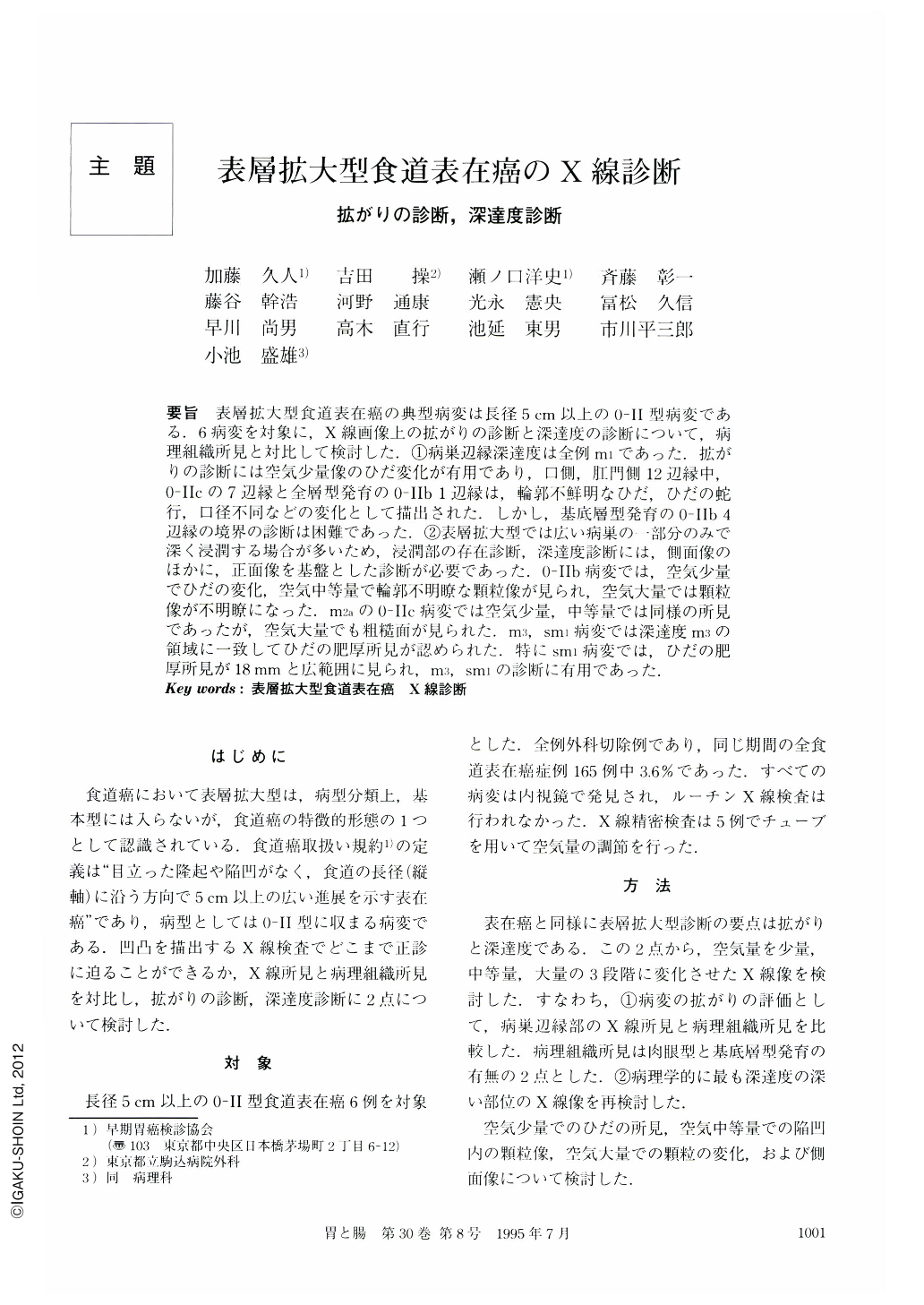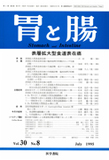Japanese
English
- 有料閲覧
- Abstract 文献概要
- 1ページ目 Look Inside
- サイト内被引用 Cited by
要旨 表層拡大型食道表在癌の典型病変は長径5cm以上の0-Ⅱ型病変である.6病変を対象に,X線画像上の拡がりの診断と深達度の診断について,病理組織所見と対比して検討した.①病巣辺縁深達度は全例m1であった.拡がりの診断には空気少量像のひだ変化が有用であり,口側,肛門側12辺縁中,0-Ⅱcの7辺縁と全層型発育の0-Ⅱb1辺縁は,輪郭不鮮明なひだ,ひだの蛇行,口径不同などの変化として描出された.しかし,基底層型発育の0-Ⅱb4辺縁の境界の診断は困難であった.②表層拡大型では広い病巣の一部分のみで深く浸潤する場合が多いため,浸潤部の存在診断,深達度診断には,側面像のほかに,正面像を基盤とした診断が必要であった.0-Ⅱb病変では,空気少量でひだの変化,空気中等量で輪郭不明瞭な顆粒像が見られ,空気大量では顆粒像が不明瞭になった.m2aの0-Ⅱc病変では空気少量,中等量では同様の所見であったが,空気大量でも粗糙面が見られた.m3,sm1病変では深達度m3の領域に一致してひだの肥厚所見が認められた.特にsm1病変では,ひだの肥厚所見が18mmと広範囲に見られ,m3,sm1の診断に有用であった.
According to the definition by the Japanese Society for Esophageal Diseases, superficial spreading type carcinoma is recognized as a superficial flat type lesion expanding to more than 5cm in diameter. Using this definition, this study was made concerning radiological findings of six superficial spreading type carcinomas. Twelve oral and anal margins of six lesions were intraepithelial carcinomas. In radiological examination seven type 0-Ⅱc margins and one 0-Ⅱb margin with total epithelial layer type growth showed slight changes of longitudinal folds, unclearly-outlined folds, windings of folds, and width changes of folds. It was difficult to detect borders of other four 0-Ⅱb margins with basal cell layer type growth. As some superficial spreading type legions had deepest invasion to mucosal or submucosal layer only in small regions, it was necessary in radiological examination, to make a diagnosis of the depth of invasion not only from the profile view but from the enface view. Radiological findings of m1 carcinoma were changes of folds depicted by a small amount of air, unclearly-outlined granules depicted by a midlum amount of air, and disappearance of granules depicted by a large amount of air. m2 invasion could be differentiated from m1 carcinoma by granules remaining in a large amount of air. Granules in the m3 invading carcinomas had clear outlines and irregular shapes in medium or large amount of air. Distinct findings of m3 invasion were thick folds, or wider and higher fold than folds on normal mucosa. Though there were no findings to distinguish sm1 invasion from m3 or other deeper submucosal invasion, sm1 invasion could be suspected by a broad region showing thick folds.
The findings concerning of slight changes of folds were useful to detect margins of superficial spreading lesions, and appearance of granules and thick folds were findings for effectual diagnosis of depth of invasion.

Copyright © 1995, Igaku-Shoin Ltd. All rights reserved.


